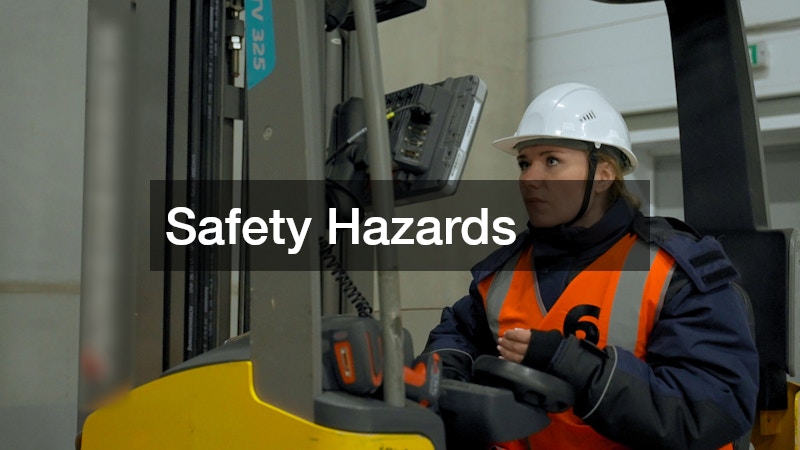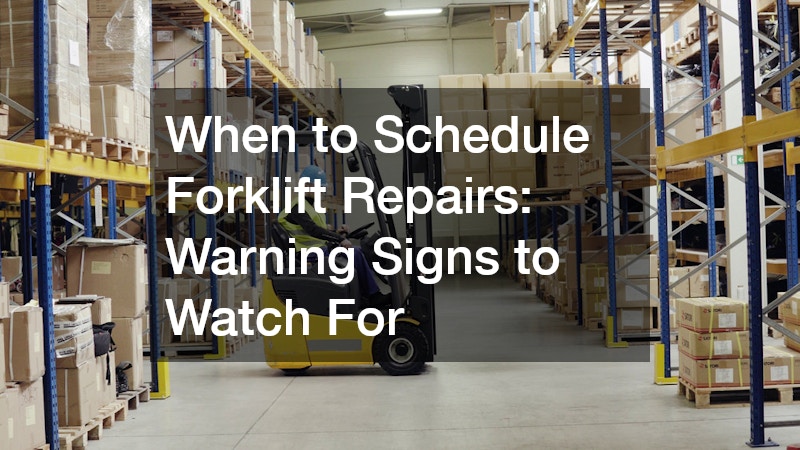Forklifts are essential equipment in many industrial environments, but like all machines, they require regular maintenance and repairs to ensure they operate safely and efficiently. Knowing when to schedule repairs can be crucial in preventing accidents and costly breakdowns. In this article, we’ll explore some key warning signs that indicate it’s time for a repair and answer some frequently asked questions on the topic.
The Most Common Signs that a Forklift Needs Repair
Unusual Noises
Unusual noises emanating from a forklift are often early indicators of underlying mechanical problems. These noises can range from squeaks and grinding sounds to bangs and clunks, each potentially pointing to different issues.
For example, a grinding noise might indicate problems with the brakes or the transmission system.
It’s imperative to investigate these sounds promptly to prevent further damage and ensure safety. Failure to address these noises can lead to more severe mechanical failures that could impede operations. Consequently, training operators to recognize these auditory cues can be vital in maintaining equipment health.
In some cases, the cause of the noise may be as simple as a loose or worn-out part that needs tightening or replacement. Regular inspections can help identify these issues before they escalate into more significant problems. By being proactive, businesses can reduce the risk of unexpected breakdowns and maintain steady productivity levels.
Hydraulic Issues
Hydraulic systems are critical for the lifting and lowering operations of forklifts, and any issues in this area should be taken seriously. Symptoms of hydraulic problems include slow lifting, unusual vibrations, and visible leaks. These signs indicate that immediate attention is required to prevent potential system failure.
Not only do hydraulic issues affect the operational capacity of the forklift, but they also pose significant safety risks. A malfunctioning hydraulic system could lead to dropped loads or loss of control, resulting in workplace accidents. It is therefore essential to regularly check the hydraulic fluid levels and inspect hoses and seals for wear and tear.
Detecting hydraulic problems early can save companies from costly repairs and downtime. Routine maintenance schedules should include hydraulic system checks to ensure everything is in proper working order. By doing so, businesses can maintain the longevity of their forklifts and support a safe working environment.
How Regular Maintenance Can Prevent Forklift Repairs
Scheduled Inspections
Scheduled inspections play a crucial role in the early detection of potential forklift issues. Regularly examining the equipment allows technicians to identify and address minor problems before they evolve into major failures. A well-documented maintenance history provides insights into recurring issues and helps in planning preventive measures.
These inspections should cover all aspects of the forklift, including brakes, tires, steering mechanisms, and fluid levels. By implementing a comprehensive checklist, maintenance teams can ensure all potential problem areas are scrutinized. Optimal scheduling of inspections can lead to a significant reduction in unscheduled downtime and repair costs.
Proper Operator Training
The role of properly trained operators is significant in recognizing early signs of mechanical issues in forklifts. Operators are often the first line of defense against malfunction, as they interact with the machinery on a daily basis. Through focused training programs, operators can learn to identify unusual behaviors and alert the maintenance team promptly.
These training programs should emphasize the importance of daily pre-operation checks, as these practices enable operators to spot anomalies like fluid leaks or tire damage early. Additionally, understanding the operational limits of the forklift prevents overloading, which can be a source of mechanical strain. Overall, skilled operators contribute significantly to the longevity of the equipment.
The Consequences of Ignoring Forklift Warning Signs
Increased Operational Costs
Ignoring warning signs on forklifts can lead to increased operational costs, primarily due to the necessity of expensive emergency repairs. When minor issues expand unchecked, they often cause significant damage, forcing companies to spend heavily on parts and labor. Moreover, unexpected downtime due to equipment failure can halt operations, impacting productivity and revenue.
Besides the direct repair costs, ancillary expenses such as rental fees for replacement equipment and overtime wages for the workforce can accumulate. These hidden costs can strain a company’s budget, making it evident that proactive maintenance is a more economical choice. By identifying and correcting minor issues, businesses can avoid these financial pitfalls.
Safety Hazards
Safety is paramount in any industrial setting, and neglecting forklift repairs can severely compromise workplace safety. Malfunctioning forklifts pose significant hazards, potentially leading to accidents, injuries, or even fatalities. Conditions such as faulty brakes or unstable loads due to hydraulic failure can endanger both the operator and nearby personnel.
In addition to personal injury risks, these safety issues can result in property damage and costly legal liabilities. Companies may face fines and policy violations if found non-compliant with safety regulations. This scenario not only damages financial health but also tarnishes a business’s reputation in the industry.
Recognizing the warning signs that a forklift needs repair is crucial for maintaining a safe and productive work environment. By staying vigilant and adhering to maintenance schedules, operators and managers can prevent costly breakdowns and enhance operational efficiency. Implementing regular checks and a proactive maintenance approach will safeguard not only the machinery but also the safety and well-being of the workforce.




